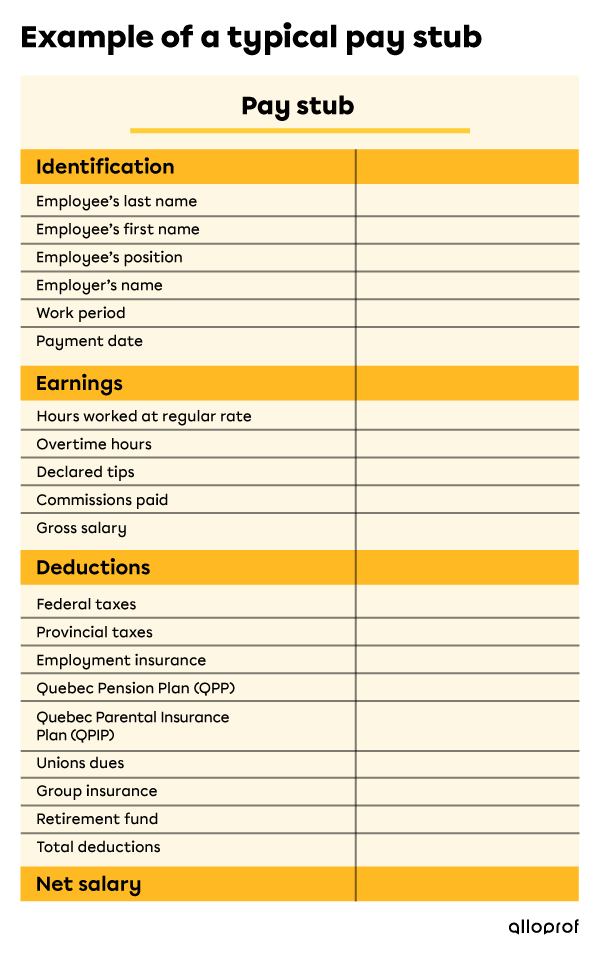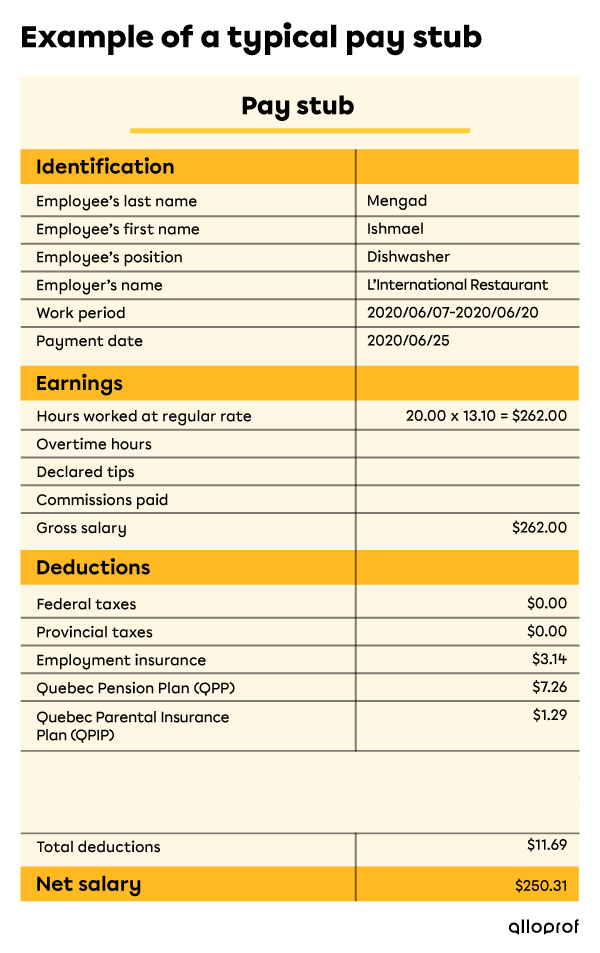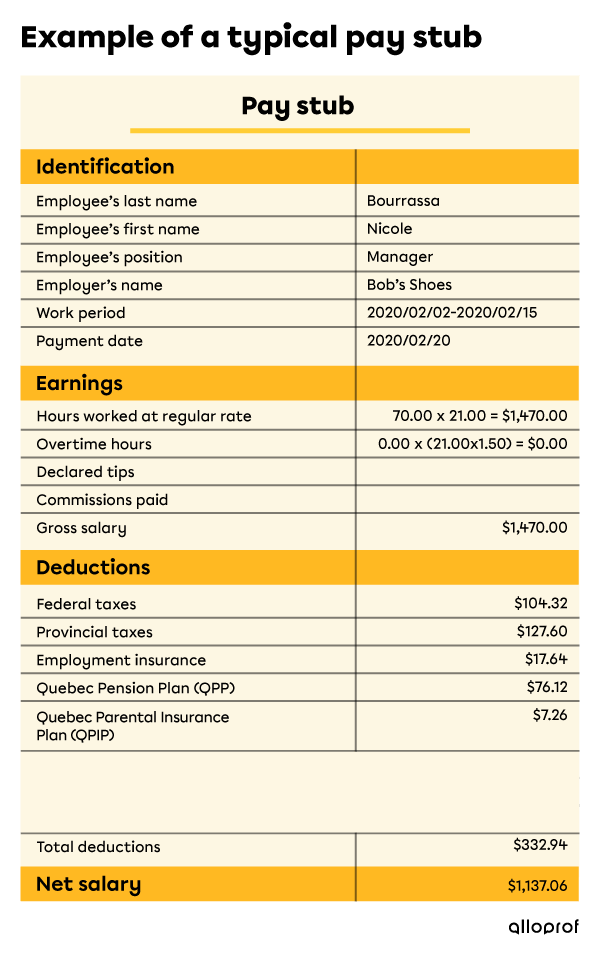Information relating to salary and taxes changes over time. The data presented in this sheet is meant to provide a general overview. For up-to-date information, consult the following websites:
It is the moment you have been waiting for: your first paycheque. You think to yourself, “I’m finally going to be able to spend all the money I’ve earned and go on a shopping spree!” But then, you realize that the amount deposited into your account is not the same as the total pay for the hours you worked.
You try to figure it out by looking at your first pay slip, but it seems so complicated. Where did your money go? How can you understand this document?

Employers provide each employee with a pay stub, generally every two weeks. This pay stub is divided into four sections:
-
identification
-
earnings
-
deductions
-
net pay
The following information can be found in the Identification section:
-
the employee’s last name, first name and position
-
the employer’s name
-
the work period
-
the date of payment
In the Earnings section, you can see the hours worked at the regular rate. You can also see:
-
the money earned during overtime
-
declared tips
-
commissions paid
-
bonuses and compensation
-
This information is called gross income.
Compensation is money paid to a worker for a particular situation. For example, when workers lose a job through no fault of their own, they receive compensation.
In the deductions or source deductions section, you will find all the contributions, both mandatory and not.
A source deduction is an amount of money or a contribution deducted by the employer directly from the worker’s pay. The employer then gives the money to the government or to a union, as appropriate.
The Net Pay section shows the amount of money left after deductions are taken from the gross pay. The net pay is the amount you are paid.
In short: Gross Pay - Deductions = Net Pay

Ismael Mengad is 18 years old and works as a dishwasher at the restaurant L’International. This is his first job. He works 10 hours a week on weekends and is paid $13.10 an hour, the minimum wage. Ismael is paid every two weeks. His first pay deposited is $250.31, although according to his calculations, he earned $262. What happened to the missing $11.69?
When he looks at his pay stub, he notices a section called Deductions which indicates that:
-
$3.14 goes to Employment Insurance contributions
-
$7.26 goes to the Quebec Pension Plan (QPP)
-
$1.29 goes to the Quebec Parental Insurance Plan (QPIP)
He also notices that no amount was deducted for federal and provincial taxes. Did his employer make a mistake? His employer explains that, since he is only working part-time and will only earn a little over $6,800 this year, his income will not be high enough to pay taxes. In 2020, the basic personal amount for not paying taxes was $13,229 at the federal level (Canada) and $15,532 at the provincial level (Quebec).

Nicole Bourrassa has been a store manager at Bob’s Shoes for many years. She works 35 hours per week at an hourly rate of $21 per hour.
Her gross income for the last two weeks is $1,470, but only $1,137.06 has been deposited into her account. Like all employees, Nicole has several deductions from her pay:
-
$104.32 goes to federal taxes
-
$127.60 goes to provincial taxes
-
$17.64 goes to Employment Insurance
-
$76.12 goes to the Quebec Pension Plan (QPP)
-
$7.26 goes to the Quebec Parental Insurance Plan (QPIP)
The total amount of these deductions is $332.94.
As you have seen in the pay stub examples, there is a difference between net pay and gross pay. The difference comes from source deductions, commonly known as deductions or contributions. Some contributions are mandatory while others are optional, depending on the employer and the type of employment. Here is a table that shows the possible source deductions:
| Mandatory deductions for all workers | Optional deductions for all workers |
|---|---|
| Federal Tax | Group insurance |
| Provincial tax | Retirement |
| Quebec Pension Plan (QPP) | Union |
| Quebec Parental Insurance Plan (QPIP) | |
| Employment Insurance |
Once you start working, you financially contribute to society. Your financial contribution helps pay for government programs and services such as health care and education.
Federal tax contributions are mandatory if you earn more than the basic amount annually. In 2020, this amount was $13,229. If you earn less than that amount, you will not have to contribute.
Provincial tax contributions are also mandatory if your income is above the annual basic personal amount. In 2020, this amount was $15,532. If you earn less than that amount, you do not have to contribute.
If you earn more than $3,500 a year and are 18 years of age or older, you will contribute to the Quebec Pension Plan. This plan provides basic financial security at retirement to people who have contributed to it, as well as providing financial protection in case of disability, should a contributor be unable to work. It also offers various amounts to loved ones if the contributor dies.
In 2020, workers and employers contributed to the plan at a rate of 5.7% of the employee’s earnings. For example, an employee earning $500 a week pays $28.50 to QPP and their employer pays the same amount.
The Quebec Parental Insurance Plan offers maternity, paternity and adoption benefits to employed and self-employed parents upon the birth or adoption of a child. This contribution is mandatory for everyone. In 2020, the contribution rate for an employee was 0.494% of gross income, while the employer’s contribution rate was 0.692% of the employee’s gross income.
Gross income refers to the amount of income deducted before taxes and other deductions (source deductions such as Quebec Pension Plan, employment insurance, union dues, etc.).
This last contribution is also mandatory, and its rate varies according to income. This program provides a basic income to people who are unemployed.
Unemployment refers to a period of time when a person is unemployed, but is able to work and is actively seeking employment.
Here is how the annual contributions of the two employees shown in the example above might look.
Nicole earns a gross income of $38,220 per year and contributes $8,656.44 in various contributions, giving her a net income of $29,563.56.
Ishmael pays $303.94 in various contributions on a gross annual income of $6,812, which gives him a net income of $6,508.06.
| Nicole Bourrassa | Ishmael Mengad | |
|---|---|---|
| Federal tax | $2,712.32 | $0.00 |
| Provincial tax | $3,317.60 | $0.00 |
| Employment Insurance | $458.64 | $81.64 |
| Quebec Pension Plan (QPP) | $1,979.12 | $188.76 |
| Quebec Parental Insurance Plan (QPIP) | $188.76 | $33.54 |
| Total | $8,656.44 | $303.94 |
Net income is the amount of deducted income after taxes and other deductions (Quebec Pension Plan, employment insurance, union dues, etc.).
In addition to the mandatory contributions, there may be other source deductions on your pay slip, depending on your work situation. For example, an employer could offer a pension plan to its employees for their retirement. It could also offer group insurance to cover various expenses such as dental care or medical expenses. In a unionized company, you also have to pay union dues. This is mandatory, although there are a few exceptions.
Be sure to ask someone in human resources and in payroll where you work. There are also online resources such as the Éducaloi and Commission des normes, de l’équité, de la santé et de la sécurité du travail (CNESST) websites.
The amounts and calculations presented in this concept sheet are intended to be as close as possible to reality. However, some amounts may differ slightly from reality.
In 1996, the Quebec National Assembly adopted the Pay Equity Act. Companies with 10 or more employees must verify whether female-dominated jobs, meaning jobs done mainly by women, are paid less than male-dominated jobs. Nursing is an example of a female-dominated job.
The main idea of the law is “equal pay for equal work,” but also “equal pay for different but equivalent work.” Qualifications, responsibilities, efforts required and the conditions under which the work is performed are taken into consideration for this evaluation.
According to Statistics Canada, female employees between the ages of 25 and 54 earned an average of $4.13 less per hour than men in the same age group in 2018, a 13.3% gap. It means a female employee will earn $0.87 on average for every dollar earned by a male employee. Although the gap has decreased since 1998 in Canada, more action is needed to support pay equity.
In a company that makes women’s clothing, there are dressmakers, a predominantly female job, and clerks, who are mostly men. The average wage for dressmakers in this company is $15 per hour compared to $17.50 for clerks.
With 25 employees, the company must evaluate the pay equity of its workers this year. A committee concluded that these two jobs are equivalent without being identical. Both jobs require a vocational degree or high school diploma and involve similar responsibilities and efforts. The company decided to pay both jobs at the same hourly rate of $17.50 per hour.
McSween, P.-Y., Dupuis, D., Fournier, P., Ménard, E. and Grammond, S. (2017). Profil [Manuel de l’élève]. ERPI.
Coziol, M., Giguère, H., Mainville-M., C. and Wilson, S. (2018). Mes dossiers [Manuel de l’élève]. Les Éditions CEC.
Choquette-Bernier, N., Fontaine, V., Lizotte, C., Moore, J.-F. and Rochon, X. (2018). Finances en jeu [Manuel de l’élève]. Chenelière Éducation.
Agence de revenu du Canada. (2020, June 25). Indexation de montants aux fins de l’impôt et des prestations des particuliers. https://www.canada.ca/fr/agence-revenu/services/impot/particuliers/foire-questions-particuliers/rajustement-montants-fonction-indexation-impot-particuliers-prestations.html
Pelletier, R., Patterson, M. and Moyser, M. (2019, October 11). L’écart salarial entre les sexes au Canada : 1998 à 2018. Statistiques Canada. https://www150.statcan.gc.ca/n1/pub/75-004-m/75-004-m2019004-fra.htm
Retraite Québec. (n.d.). Comment sont calculées les cotisations?. https://www.rrq.gouv.qc.ca/fr/programmes/regime_rentes/travail_cotisations/Pages/calcul_cotisations.aspx
Retraite Québec. (n.d.). Les cotisations au Régime de rentes du Québec. https://www.rrq.gouv.qc.ca/fr/programmes/regime_rentes/travail_cotisations/Pages/travail_cotisations.aspx#exemption
Revenu Québec. (n.d.). Principaux changements pour l’année 2020. https://www.revenuquebec.ca/fr/entreprises/retenues-et-cotisations/trousse-employeur/principaux-changements-pour-2020/